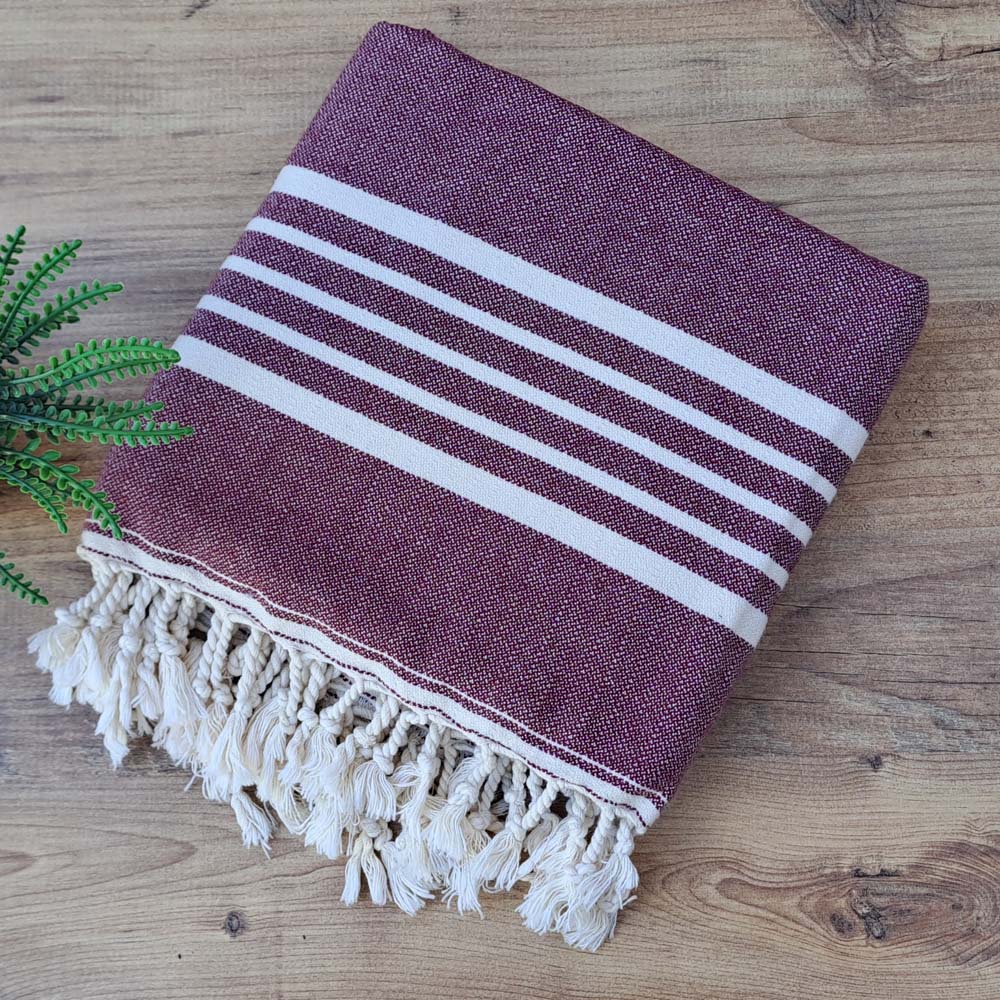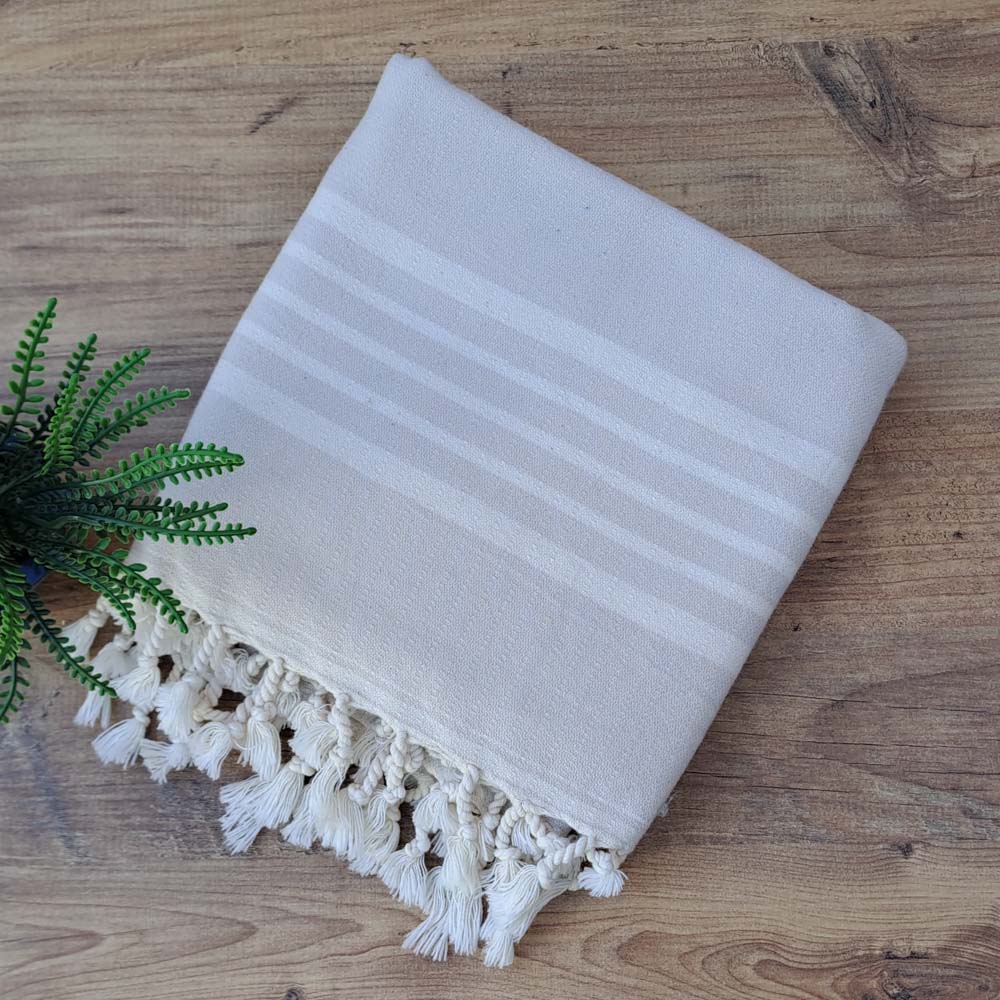Turkish beach towels are recognized around the world for their elegant designs and superior quality. Handwoven by hand in Anatolia for centuries, these towels are both lightweight and highly absorbent. So what is the secret to the uniqueness of these towels? If you are wondering how traditional Turkish beach towels are produced, you are in the right place. In this article, we will share the details of the production process and discover the story behind this unique product that is an important part of Turkish culture. Let’s embark on this special journey together!

You may be interested in this article. What makes Turkish Peshtemal towels so special?
History of the Turkish Towel
The history of Turkish towels dates back to the Ottoman Empire. Known then as “peshtamal”, these thin and light woven products were an indispensable part of the Turkish bath culture. Woven on traditional hand looms in different regions of Anatolia, these towels were produced by master artisans using techniques passed down from generation to generation. Throughout history, Turkish towels have gained fame both in daily life and by reaching different parts of the world through trade routes. Even today, this heritage is kept alive by preserving traditional production methods.
Production Process Step by Step
1. Cotton Selection
The production of Turkish towels starts with the selection of quality Turkish cotton. This type of cotton, especially grown in the Aegean region, provides softness, durability and high absorbency to the towel thanks to its long fiber structure.
2. Yarn Spinning
Selected cotton fibers are spun into yarn using traditional methods or machines. In traditional production, the hand spinning method is still used. This method makes the yarn more natural, soft and durable.
3. Hand Woven Looms
The prepared yarns are woven by hand by craftsmen on traditional wooden hand looms. In this process, each towel is shaped by the labor of the master. The weaving speed is slow but the result is flawless. This is where the unique texture and quality of towels comes from.
4. Patterns and Colors of the Towel
Woven towels are often decorated with patterns reflecting Anatolian culture. The patterns carry traditional motifs. Coloring is done using natural dyes. The colors obtained with this method are permanent, vibrant and environmentally friendly.
What Makes Turkish Towels Special
High Absorbency and Fast Drying
Turkish towels have high absorbency thanks to their fine texture. It quickly absorbs moisture on the skin and dries in a short time. In this way, it offers practical use both at the beach and in the bathroom.
Lightweight and Compact Structure
Traditional Turkish towels are light and thin. They take up much less space than normal towels. Easy to carry when traveling and sports activities.
Durability
Thanks to the long fibers obtained from Turkish cotton, Turkish towels are very durable. Despite frequent use and washing, it retains its form and even becomes softer and more comfortable over time.
Environmentally Friendly and Natural Production
Turkish towels are usually made with natural cotton and dyes. This makes them environmentally friendly and safe for skin health. It is an ideal choice for those who support sustainable living.
Uses of Turkish Towels
Beach and Pool
Turkish towels are frequently preferred at the beach and pools due to their lightness and fast drying properties. Thanks to its sand-repellent texture, it provides comfort on the beach and is easy to clean.
Travel and Camping
Compact and lightweight, it is a favorite among travelers and campers. It takes up little space in the suitcase, dries quickly and can be easily carried on long trips.
Yoga and Sports
Ideal for yoga and sports practitioners with its soft texture and high absorbency. It quickly absorbs perspiration and offers coolness and comfort after exercise. Lightweight and easy to carry in a sports bag.
Things to Consider When Buying Turkish Towels
Fabric Quality
Cotton is the most important factor that determines the quality of Turkish towels. Choose towels made from 100% Turkish cotton. Towels woven from long-fiber cotton are softer and more durable.
Weaving Technique
Traditional hand-woven towels are more valuable than machine-woven towels. Hand-woven towels are more durable and aesthetic. Towels with a high weave density provide better absorbency.
Dyeing Method
Towels using natural dyes are skin-friendly and harmless to the environment. Synthetic dyed towels may fade quickly or cause skin irritation.
Weight and Thickness
The most distinctive feature of Turkish towels is their light and thin structure. Towels that are too thick and heavy do not reflect the characteristics of a traditional Turkish towel. The ideal towel should be light, fast drying and take up little space.
Brand Reliability
Choose trusted and well-known brands. Brands that produce certified and authentic products provide assurance of the quality and authenticity of the towel.




